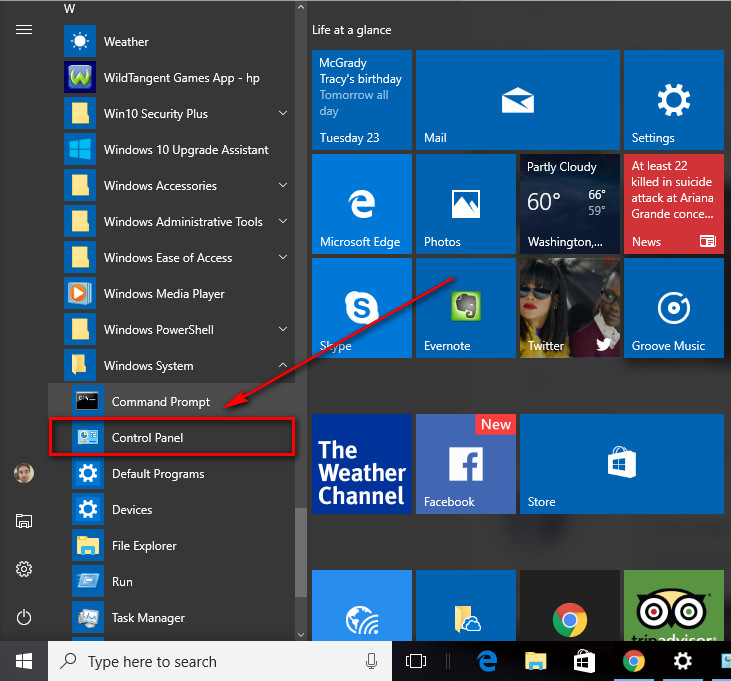That said, Control Panel is still exist in Windows 10 and is identical to the one in previous Windows iterations. If you prefer using the classic Control Panel over the Settings app, simply follow the instructions mentioned in one of the given below methods to open the classic Control Panel in Windows 10. Tips: If you often use Control Panel, I recommend you Create Control Panel Shortcut on Windows 10 Desktop. 7 ways to open Control Panel in Windows 10: Way 1: Open it in the Start Menu. Click the bottom-left Start button to open the Start Menu, type control panel in the search box and select Control Panel in the results. With the old Windows Start menu, you could add the Control Panel as a menu or a drop-down list. With Windows 8 or Windows 10, you can pin the Control Panel to the Start Screen and taskbar but first you need to know where it is.
Control Panel is the centralized configuration area in Windows. It's used to make changes to nearly every aspect of the operating system.
This includes keyboard and mouse function, passwords and users, network settings, power management, desktop backgrounds, sounds, hardware, program installation and removal, speech recognition, parental control, etc.
Think of Control Panel as the place to go in Windows if you want to change something about how it looks or works.

How to Access the Control Panel
In recent versions of Windows, Control Panel is accessible from the Windows System folder or category in the Apps listing.
In other versions of Windows, click Start and then Control Panel or Start, then Settings, then Control Panel.
See How to Open Control Panel for detailed, operating system specific directions.
Control Panel can also be accessed in any version of Windows by executing control from a command line interface like Command Prompt, or from any Cortana or Search box in Windows.
Although it's not an 'official' way to open and use the options in Control Panel, there's also a special folder you can make in Windows called GodMode that gives you all the same Control Panel features but in a simple one-page folder.
How to Use the Control Panel
The Control Panel itself is really just a collection of shortcuts to individual components called Control Panel applets. Therefore, to use Control Panel really means to use an individual applet to change some part of how Windows works.
See our Complete List of Control Panel Applets for more information on the individual applets and what they are for.
If you're looking for a way to access the areas of Control Panel directly, without first going through Control Panel, see our List of Control Panel Commands in Windows for the commands that start each applet. Since some applets are shortcuts to files with the .CPL file extension, you can point directly to the CPL file to open that component.
For example, control timedate.cpl works in some versions of Windows to open the Date and Time settings, and control hdwwiz.cpl is a shortcut to Device Manager.

The physical location of these CPL files, as well as folders and DLLs that point to other Control Panel components, are stored in the Windows Registry HKLM hive, under SOFTWAREMicrosoftWindowsCurrentVersion; the CPL files are found in Control PanelCpls and all the rest are in ExplorerControlPanelNamespace.
Here are a few of the thousands of individual changes that are possible from within Control Panel:

- Change AutoPlay Settings
- Adjust the Date and Time
- Setup Windows Backup
- Change Internet Explorer Settings
- Configure Regional and Language Settings
- Configure Text to Speech and Speech Recognition Settings
- Change Network Settings
- Adjust Color Quality
- Adjust Keyboard and Mouse Settings
- Change Background, Screensaver, and Windows Sounds Settings
- Add a Printer
- Configure the Start Menu and Taskbar
- Configure Windows Firewall Settings
Control Panel Views
The applets in Control Panel can be viewed in two major ways: by category or individually. All Control Panel applets are available either way but you may prefer one method of finding an applet over the other:
Windows 10, 8, & 7: Control Panel applets can be viewed by Category which groups them together logically, or in the Large icons or Small icons view which lists them individually.
Access Control Panel In Windows 10
Windows Vista: The Control Panel Home view groups applets while the Classic View shows each applet individually.
Windows XP:Category View groups the applets and Classic View lists them as individual applets.
Generally, the category views tend to give a bit more explanation about what each applet does but sometimes makes it hard to get right to where you want to go. Most people prefer the classic or icon views of Control Panel since they learn more about what the various applets do.
Control Panel Availability
Control Panel is available in nearly every Microsoft Windows version including Windows 10, Windows 8, Windows 7, Windows Vista, Windows XP, Windows 2000, Windows ME, Windows 98, Windows 95, and more.
Open Control Panel In Windows 10
Throughout the history of Control Panel, components were added and removed in every newer version of Windows. Some Control Panel components were even moved to the Settings app and PC Settings in Windows 10 and Windows 8, respectively.
Open Control Panel In Windows 10
Even though Control Panel is available in almost every Windows operating system, some small differences do exist from one Windows version to the next.